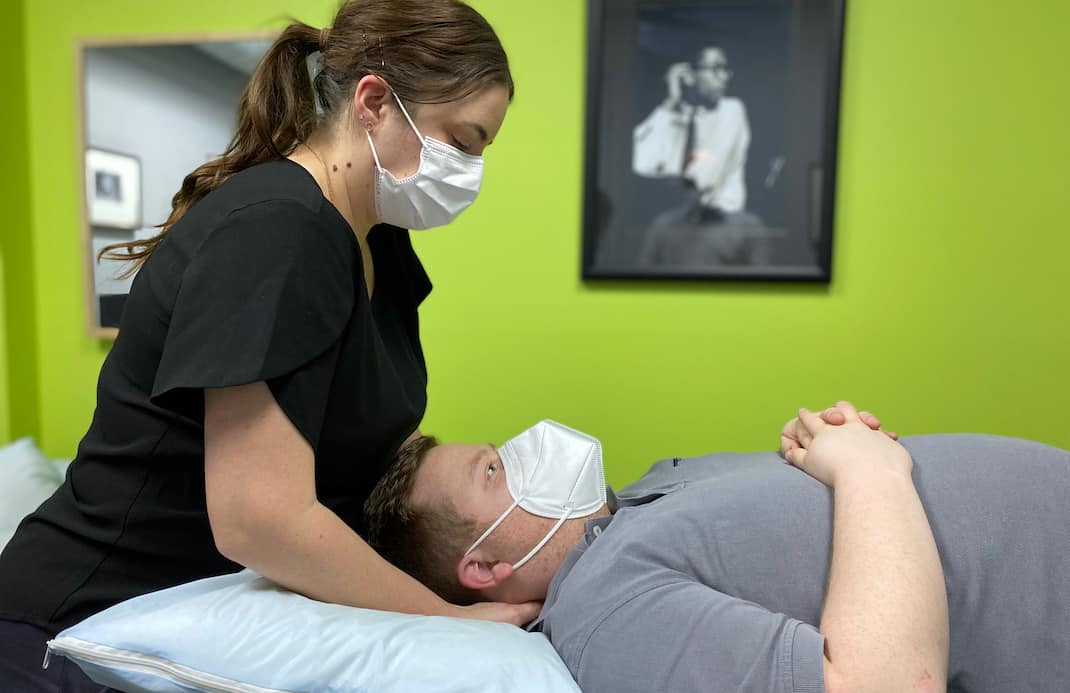This blog by Jon Papas is really handy if you are one of the many that has suddenly had to create a home office, and you need to know what to look for when shopping for home office chairs.
While a 10 step commute and working in your PJ’s has its perks, we’ve recently seen an increase in work station-related pain in clinic.
Over the last few weeks, roughly a third of the new patients I’ve seen have come in with some variation of this statement:
I’ve started working from home and now my back / neck / shoulder is really sore!
I don’t think spending 6 hours on a bed/couch/floor in front of my computer has done me any favours.
For the working population, working makes up a significant proportion of our time in any given week.
As a result, how we set ourselves up for our work day has a significant impact on our physical wellbeing.
Buying the right office chair is an important purchase, and recently we have had plenty of questions about what to look for.
Here’s our buyer’s guide on what to look for when looking at office chairs for your home home office.
1. One size does not fit all
First and foremost, your chair should fit your workstation.
Sure, the leather executive chair with neck support, arm rests and 16 cup holders looks nice, but does it fit underneath the dinner table?
Make sure the width and height of your table can accomodate whatever you decide to buy.
Important tip – make sure any arm rests fit underneath the desk.

2. Office chairs – the basics
We all come in different shapes and sizes so we all need different support in different places. As a result, our desks and chairs need to be adjustable too.
At a minimum your chair should be able to do the following:
- Be height adjustable – your chair height should allow for your thighs to pass freely underneath your desk.
Your feet should make full contact with the floor.
Those with shorter legs or taller desks may have to think about investing in a foot stool.
Adequate foot support means less pressure on the backs of you thighs and less effect on your lumbar spine. - Be an appropriate width – the seat pan (the part on which you sit – see the picture below) can also come in various sizes.
Make sure the one you choose is big enough to evenly support the back of your legs.
If the seat is too narrow, it will result in additional pressure on your outer thighs, especially if there are arm rests. - Have appropriate back support – in the modern ergonomic debate (yes, it’s a thing), there are two schools of thought when it comes to the appropriate amount of back support.
Some argue that more points of contact result in more support and therefore lowers the risk of injury.
Others say that no support forces the body to maintain strong a posture and therefore… lowers injury chance.
See the problem? Who’s right?
Like everything else, what is best is going to vary from person to person.
We tend to think that if you use a back rest, make sure it supports your mid back to mid shoulder blade at a minimum.

Important tip – these features are mandatory.
3. Office chairs – bells and whistles
Height adjustability, appropriate width and adequate support are the very basics.
The following features allow you to set up your chair more specifically to fit you.
We would suggest looking for each of these features when you buy a chair. You are going to be able to adjust more elements and have get a better chance of getting it ‘just right’.
Adjustable backrest tilt: It gives you the ability to play with amount of inclination.
Like the seat in your car, a back that is slightly reclined from vertical position is ideal for supporting the upper back and reducing pressure on the low back during extended periods of sitting.
Adjustable pan depth: This gives you the ability to make the seat pan (see above) shallower or deeper.
Being able to adjust pan depth has an effect on the distribution of pressure on the back of your thighs and also on your foot placement.
If the pan is too shallow, your mid thigh will be toward the edge of the chair. Too deep and your knee will be on the edge but your buttocks might not reach the back rest.
Ideally, when sitting comfortably against the back support, there should be a 3-4cm between the end of the chair and the back of the calf.

Pan depth too shallow, thighs hanging over the edge 
Pan depth better with 3-4 cm gap to calves
Adjustable seat pan tilt – the amount of pan tilt is really personal preference.
A flat seat is generally fine. Adding tilt changes pressure created by the hips and thighs.
A slight downward tilt at the front can make is easier to sit tall, but too much forward tilt can make you feel like you are sliding forward on the seat.
Important tip – these are all good features to look for in a office chair that you plan on spending plenty of time sitting on.
It is worth being able to refine all these elements to make the chair fit you best and feel like yours.
4. To arm rest or not to arm rest?
Arm rests are a tricky topic.
Sure, they look good, but they can also get in the way. From what we’ve looked into, they tend to hinder more than they help.
In the end, it is completely dependent on the workstation and your personal preferences.
If you are thinking about a chair with armrests, go through the following checklist. Can you:
- rest your forearms on the arm rests and still comfortably reach your keyboard?
- bear weight evenly through both arms without being inclined to slouch to one side?
- set the rests to a height where they provide support without forcing you to shrug?
If you answered YES to all of the above, and it satisfies Tip 1 (ie fitting under the desk!) then you have our blessing!
Important tip – adjustable arm rests are definitely better than fixed ones.
Happy shopping!
If you have any questions about office chairs, the different variables, and whether a feature is important or not, I am happy to discuss this with you.
An independent opinion is useful sometimes.
Bear in mind that the most expensive one isn’t always going to be necessary or even the best one for you.
In summary, I would recommend purchasing a chair that goes beyond the basics and has the extra adjustability that you get with the extra features discussed.
I am also available to do ergonomic assessments which can be done via Telehealth video consultation.
If you are interested, give us a call on 8356 1000 or message us on Facebook and ask for an online ergonomics assessment with Jon Papas.
This process works really well online. We can look at your workstation and your office chair in real time and make changes in real time without having to leave the home office!
If you would like some advice over the phone, take advantage of a Free Physio Phone Call. Click here to get more details.

















